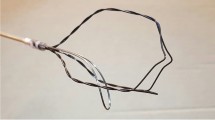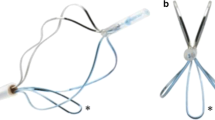Abstract
Introduction
In the last decade, there has been a growing interest in minimally invasive treatment for benign prostatic hyperplasia (BPH) associated with lower urinary tract symptoms (LUTS). In this field, one of the options currently available is the temporary implantable nitinol device (iTIND) (Medi-Tate®; Medi-Tate Ltd., Or Akiva, Israel).
Purpose of the Work
To review the recent data available in the literature regarding the role of the first-generation (TIND) and second-generation (iTIND) devices for the management of BPH with LUTS, especially focusing on follow-up of functional outcomes.
Evidence Acquisition
PubMed, Embase, and the Cochrane Central Register of Controlled Trials were screened for clinical trials on this topic.
Evidence Synthesis
Literature evidences regarding implantation of TIND and iTIND for PBH with LUTS are limited. There are only three studies available, one with a medium-term follow-up. The results of these studies suggested that both the TIND and iTIND implantations are safe, effective, and well-tolerated procedures, allowing spare ejaculation in sexually active patients.
Conclusions
Current evidences emphasize that the temporary implantable nitinol devices are promising alternatives to the standard minimally invasive surgical options for BPH-related LUTS. Further studies are needed to confirm the effectiveness over a long-term follow-up.






Similar content being viewed by others
References
Papers of particular interest, published recently, have been highlighted as: •• Of major importance
Vuichoud C, Loughlin KR. Benign prostatic hyperplasia: epidemiology, economics and evaluation. Can J Urol. 2015;22(Suppl 1):1–6.
Verhamme KM, Dieleman JP, Bleumink GS, Bosch JL, Stricker BH, Sturkenboom MC. Treatment strategies, patterns of drug use and treatment discontinuation in men with LUTS suggestive of benign prostatic hyperplasia: the Triumph Project. Eur Urol. 2003;44:539–45.
•• Dahm P, Brasure M, MacDonald R, Olson CM, Nelson VA, Fink HA, et al. Comparative effectiveness of newer medications for lower urinary tract symptoms attributed to benign prostatic hyperplasia: a systematic review and meta-analysis. Eur Urol. 2017;71(4):570–81. A complete resign of the available medical treatment of BPH.
Presicce F, De Nunzio C, Gacci M, et al. The influence of the medical treatment of LUTS on benign prostatic hyperplasia surgery: do we operate too late. Minerva Urol Nefrol. 2017;69:242–52.
Marszalek M, Ponholzer A, Pusman M, Berger I, Madersbacher S. Transurethral resection of the prostate. Eur Urol Suppl. 2009;8:504–12.
Oelke M, Bachmann A, Descazeaud A, Emberton M, Gravas S, Michel MC, et al. EAU guidelines on the treatment and follow-up of non-neurogenic male lower urinary tract symptoms including benign prostatic obstruction. Eur Urol. 2013;64:118–40.
DE Nunzio C, Lombardo R, Nacchia A, Deroma M, Alkhatatbeh H, Brassetti A, et al. Young academic urologist benign prostatic obstruction nomogram predicts clinical outcome in patients treated with transurethral resection of prostate: an Italian cohort study. Minerva Urol Nefrol. 2017. https://doi.org/10.23736/S0393-2249.17.03008-9.
Geavlete P. Is classical transurethral resection of the prostate, the gold standard endoscopic treatment for benign prostate hyperplasia, in real danger of being replaced? Eur Urol. 2010;58:356–9.
Rieken M, Presicce F, Autorino R, DE Nunzio C. Clinical significance of intravesical prostatic protrusion in the management of benign prostatic enlargement: a systematic review and critical analysis of current evidence. Minerva Urol Nefrol. 2017;69(6):548–55.
Brassetti A, De Nunzio C, Delongchamps NB, Fiori C, Porpiglia F, Tubaro A. Green light vaporization of the prostate: is it an adult technique? Minerva Urol Nefrol. 2017;69:109–18.
Gravas S, Bachmann A, Reich O, Roehrborn CG, Gilling PJ, De La Rosette J. Critical review of lasers in benign prostatic hyperplasia (BPH). BJU Int. 2011;107:1030–43.
Naspro R, Gomez Sancha F, Manica M, Meneghini A, Ahyai S, Aho T, et al. From “gold standard” resection to reproducible “future standard” endoscopic enucleation of the prostate: what we know about anatomical enucleation. Minerva Urol Nefrol. 2017;69(5):446–58.
Helo S, Holland B, McVary KT. Convective radiofrequency water vapor thermal therapy with Rezūm system. Curr Urol Rep. 2017;18(10):78.
Gratzke C, Bachmann A, Descazeaud A, Drake MJ, Madersbacher S, Mamoulakis C, et al. EAU guidelines on the assessment of non-neurogenic male lower urinary tract symptoms including benign prostatic obstruction. Eur Urol. 2015;67(6):1099–109.
Gratzke C, Barber N, Speakman MJ, Berges R, Wetterauer U, Greene D, et al. Prostatic urethral lift vs transurethral resection of the prostate: 2-year results of the BPH6 prospective, multicentre, randomized study. BJU Int. 2017;119:767–75.
•• Porpiglia F, Fiori C, Bertolo R, Garrou D, Cattaneo G, Amparore D. Temporary implantable nitinol device (TIND): a novel, minimally invasive treatment for relief of lower urinary tract symptoms (LUTS) related to benign prostatic hyperplasia (BPH): feasibility, safety and functional results at 1 year of follow-up. BJU Int. 2015;116(2):278–87. Literature showing clinical results of the temporary implantable nitinol device.
•• Porpiglia F, Fiori C, Amparore D, Kadner G, Manit A, Valerio M, et al. Second-generation of temporary implantable nitinol device for the relief of lower urinary tract symptoms due to benign prostatic hyperplasia: results of a prospective, multicentre study at 1 year of follow-up. BJU Int. 2018;123:1061–9. https://doi.org/10.1111/bju.14608. Literature showing clinical results of the temporary implantable nitinol device.
Ahyai SA, Gilling P, Kaplan SA, Kuntz RM, Madersbacher S, Montorsi F, et al. Meta-analysis of functional outcomes and complications following transurethral procedures for lower urinary tract symptoms resulting from benign prostatic enlargement. Eur Urol. 2010;58(3):384–97.
Magistro G, Chapple CR, Elhilali M, Gilling P, McVary KT, Roehrborn CG, et al. Emerging minimally invasive treatment options for male lower urinary tract symptoms. Eur Urol. 2017;72(6):986–97.
Wei JT, Dunn RL, Litwin MS, Sandler HM, Sanda MG. Development and validation of the expanded prostate cancer index composite (EPIC) for comprehensive assessment of health-related quality of life in men with prostate cancer. Urology. 2000;56:899–905.
•• Porpiglia F, Fiori C, Bertolo R, Giordano A, Checcucci E, Garrou D, et al. Three-year follow-up of temporary implantable nitinol device (TIND®) implantation for the treatment of benign prostatic obstruction. BJU Int. 2018;122:106–12. https://doi.org/10.1111/bju.14141. Literature showing clinical results of the temporary implantable nitinol device.
Author information
Authors and Affiliations
Consortia
Corresponding author
Ethics declarations
Conflict of Interest
Daniele Amparore, Sabrina De Cillis, Gabriele Volpi, Enrico Checcucci, Matteo Manfredi, Ivano Morra, Michele Di Dio, Cristian Fiori, and Francesco Porpiglia each declares no potential conflicts of interest.
Human and Animal Rights and Informed Consent
This article does not contain any studies with human or animal subjects performed by any of the authors.
Additional information
Publisher’s Note
Springer Nature remains neutral with regard to jurisdictional claims in published maps and institutional affiliations.
This article is part of the Topical Collection on Benign Prostatic Hyperplasia
Rights and permissions
About this article
Cite this article
Amparore, D., De Cillis, S., Volpi, G. et al. First- and Second-Generation Temporary Implantable Nitinol Devices As Minimally Invasive Treatments for BPH-Related LUTS: Systematic Review of the Literature. Curr Urol Rep 20, 47 (2019). https://doi.org/10.1007/s11934-019-0912-6
Published:
DOI: https://doi.org/10.1007/s11934-019-0912-6




